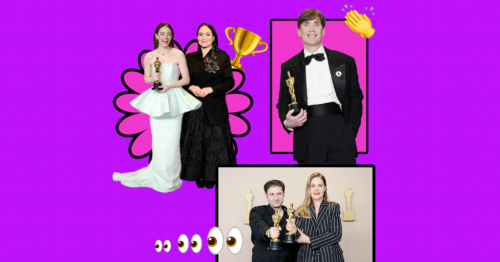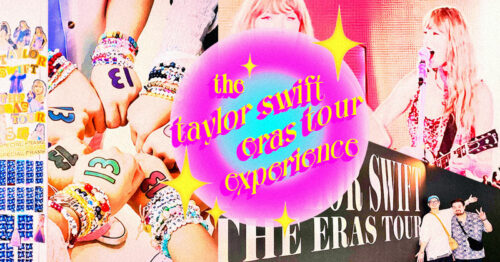A trend-less trend, an aesthetic without an aesthetic. Is corecore really what everybody says it is?
“That’s fear-based art.” –brakence, “teeth”
The 1982 experimental film Koyaanisqatsi, a word from the Hopi language, opens with the definition of its title. “1. Crazy life. 2. Life in turmoil. 3. Life out of balance. 4. Life disintegrating. 5. A state of life that calls for another way of living.“ What follows is a sequence of vignettes that captures mundane human activity, the mechanical workings of modern society and the movements of the natural world, set to evocative scoring by Brian Eno. It uses non-conventional filmic language to communicate not so much a plot, but a tapestry of feeling.
Four decades later, the advent of the internet rains down upon anyone with a smartphone a terrible abundance of information and content. Trends are born and die in a blink. From the rubble, a trend that claims to be trend-less emerges, in the form of video compilations on TikTok that stitch together seemingly random vignettes of content, from Fortnite dances to candid footage of exhausted service workers having meltdowns. Corecore—the core to end all cores.
The name of it is tongue-in-cheek, a self-aware reference to how easy it is to graft the “core” suffix to an aesthetic or vibe (see: cottagecore, normcore, goblincore—you get the idea). Explore the “corecore” hashtag on Tiktok (or “nichetok”) and you’ll get videos and/or slideshows that seem unbound to any single aesthetic, and edit together various memes, GIFs, disparate clips, pop culture references and shreds of content to form a collage-like piece of media. It is implied that corecore videos, in an artistic sense, are the products of an imagination that is terminally, absurdly online.
@derekbxxx Social media ruins lives #corecore #coretok #nichetok #mentalhealth #fyp #xyzbca #foryou #foryoupage ♬ origineel geluid – 🎧
RELATED: Breaking Down Gen Z Trends And All Their “-Core” Aesthetic
According to KnowYourMeme, corecore as a thing came to prominence in 2022, then grew to greater notoriety in 2023. YouTuber Noah Samsen identifies the thematic tendencies of “sadness/melancholy, sillyness/mirth, nihilism,” plus the usage of contemplative audio. (QKThr by Aphex Twin and Limerence by Yves Tumor are great examples of corecore music). A video essay by angle, down below, gives us the handy definition of corecore as “the self-examination/rebranding of what a ‘core’ or aesthetic can be, and notes that corecore comes from the current generation’s “struggle with creating genuine art.”
Corecore Tiktoks come in different flavors, as Samsen has noted. Some are made for a laugh, others evoke a deep sense of nihilism and self-pity. There’s something to be said about how the digital mechanisms that make corecore possible also enables the BS that indoctrinates young men into the manosphere (Joe Rogan comes up concerningly often in corecore videos), but that’s practically a separate discussion. My personal favorite corecore videos are the ones that stitch together other TikToks, as if to articulate a commentary on TikTok itself.
But as it stands, corecore videos can be reasonably described as commentary, of having to say. But commentary of what?
RELATED: This Instagram Is Making A Case For Wired Earphones
The essay On Hypermodernity by philosopher John David Ebert might be relevant to this discussion. It’s hella obtuse and frustratingly abstract, but it seems fitting to investigate corecore through frustrating abstractions. To paraphrase Ebert, hypermodernity can be described as a mode of society in which our experience of reality is governed by the digital. For this, the internet is to blame, and when hypermodernity announced itself, “all analogue media were liquefied, dissolved and fed into the new matrix.” We no longer experience media through cable TV or a healthy ecosystem of print media, but perfectly cut clips, deep-fried GIFs and footage of Patrick Bateman and/or George Costanza saying something crazy.
“The ontology of the individual is that of an amoral hedonist achieving sensory gratification in each present moment, which is disconnected from all others,” writes Ebert. Corecore videos have a way of injecting content straight into the vein at high speed, barely satisfying a vague urge to consume.
Corecore videos draw from so many sources that a single corecore video can’t hope to source where all its stuff comes from. The points of reference are disconnected and floating (to paraphrase Ebert) and so is the individual that makes and/or consumes corecore. “Hypermodernism has created the Hyperindividual, a new—and bizarre—kind of individual that is nothing like the traditional Western idea of the transcendent Self,” writes Ebert “for this new self is floating, discarnate, deworlded and decontextualized from all world horizons.”
The term “Hyperindividual” is a little too fancy for my taste, but there is something to be said about how the “self” Ebert describes experiences lost-ness. Corecore’s audience comes together through a shared experience of confusion, dread and helplessness. “I wish there was no phones but all the memories,” says one comment. “If social media ruins life why are you still using social media?” questions another. In the aforementioned video essay, angle notes that corecore comes from a place of self-pity, one connected to the very technology that makes corecore possible in the first place.
Koyaanisqatsi stitches together vignettes of the natural world and human activity, which inspire content. Corecore stitches together vignettes of content itself.
I remember when I was a Tumblr user back when the site was still in its Superwholock prime, logging in everyday to scroll quickly through my feed to get as much digital stuff in my veins as possible. That sensation of endlessly thumbing through the black mirror of my phone is something that a lot of corecore emulates. Corecore, at large, seems to be an aesthetic reenactment of scrolling through your phone. It is a commentary on the terrible abundance of content. The old Marshall McLuhan adage bears repeating: the medium is the message.
@corecoremain #core #corecore #coretok #real ♬ The Lonely Tree Longer – The Lonely Tree
RELATED: Mental Health in the Gen Z Era: Are Too Many Kids “Mentally Ill?”
So is corecore anti-trend? One could make a case for it, sure. As long as there is content to doom-scroll through, the spirit of corecore haunts the feed, evergreen. But video collages aren’t new, stream-of-consciousness art is older than even the beatniks, and “random” art is never as random as it purports itself to be.
Is corecore dadaist? Nah. Not even Millennial humor was dadaist, as much as this infamous Washington Post thinkpiece would like to claim. It isn’t even postmodern—though corecore creators claim that each video is up to interpretation, it’s not like corecore completely abandons meaning. It mourns the lack of solid metanarratives to cling to, but it reaches desperately towards any meaning that can make life seem worthwhile.
Is corecore the end of all other cores and aesthetics? Highly doubtful. Give it a couple of weeks, and a new aesthetic trend will emerge, which seems to be the natural course of things. Vaporwave as an aesthetic movement wanted to stand at the end of all things, and gestured towards the digital ruins of capitalism as its domain. Ultimately, vaporwave wasn’t the end of all vibes, but one vibe out of many. Same with corecore.
RELATED: What Is “Doomscrolling” And How Do You Stop It From Harming Your Mental Health?
In the spirit of embracing the shitposting sensibility, I will say that this type of scholarship hardly matters. Corecore videos can plumb great emotional and philosophical depths, but as a whole, corecore isn’t that deep. It’s young people making sense of a confusing world through the media that textures their everyday life.
For my money though, the Tiktok trend of “the indomitable human spirit” was much more artistically and philosophically enriching. But that’s just me.
Words Jam Pascual
Art Macky Arquilla


















